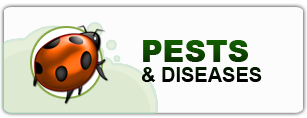Legume ipmPIPE Summary
Marie Langham and Howard Schwartz (Legume ipmPIPE National Coordinators)
Project Overview
Numerous Land Grant universities and USDA-ARS projects participated in the Legume ipmPIPE national network of sentinel plots throughout 20 U.S. states to monitor for soybean rust (SBR), common rust, root rots, soybean aphid, legume viruses (e.g., Bean common mosaic, Alfalfa mosaic, Beet curly top), white mold and common bacterial blight occurrence. Each State Coordinator: (1) confirmed involvement of local cooperators and provided diagnostic training; (2) established linkage with the State Diagnostician (National Plant Diagnostic Network contact) to share primary information on pest and disease monitoring in Sentinel Plots and/or commercial legume fields during the season; and (3) established linkage with the USDA/CSREES PIPE Web Site and protocol to access resources and upload weekly survey data that was then made available to the public. Procedures for design, crop and pest monitoring, and data reporting adhered to established national protocols. Data were reported in a timely fashion using nationally established data archives. This project participated routinely in regional and national networking activities including conference calls. Project participants contributed appropriate state-based commentaries to the online ipmPIPE information management system with methods and frequency as established by the ipmPIPE. Reports were provided in accordance with requests by the national program. Cooperators also provided verbal reports during conference calls. Training was provided to diagnosticians and field specialists on disease and pest diagnostic processes involved in the state. The project completed validation of the curtovirus specific-identification (using polymerase chain reaction) and genus-specific dot blot hybridization assay (cocktail probe), which detects 8 of 9 curtoviruses and strains in the U.S. Funds were used for sentinel plots that were monitored for these diseases and pests during 2007 to 2012. Monitoring of Sentinel Plots in North America did not detect any suspicious outbreak of soybean rust on legume crops that included soybean (northern and western states), common bean, chickpea, lentils, field pea, lima bean and/or cowpea during this period. SBR was detected on soybeans in eastern states.
Project Impacts
The Legume ipmPIPE contributed valuable information to the national program involved with monitoring the outbreak and movement of the soybean rust fungus in western and northern states. Timely reporting allowed pest management specialists to advise crop consultants and growers regarding disease status and threat. As a result, more than one million acres of common bean grown in states including Arizona, California, Colorado, Florida, Idaho, Illinois, Iowa, Kansas, Michigan, Montana, Nebraska, New Mexico, New York, North Dakota, Oregon, South Dakota, Texas, Virginia, Washington, and Wyoming were not sprayed needlessly with a preventive fungicide which provided economic benefits to growers and reduced chemical exposure to the environment and food supply. This savings is estimated to total 25 million dollars annually based on a conservative average cost of $25 per acre for a fungicide and its application. The U.S. legume industry representing the following non-soybean pulse crops (2000-2009 records from USDA-ERS) has been impacted by the Legume ipmPIPE grant of $350,000 plus participant resources of $500,000 per year with a conservative return of 5 percent ($48 million or an annual Return on Investment of 50 to 1) by reducing losses from diseases and pests affecting: Common Bean – 1,570,000 Acres valued at $461 million, Snap Bean – 100,720 Acres valued at $296 million, Cowpea – 33,000 Acres valued at $18 million, Lima Bean – 32,000 Acres valued at $29 million value, Chickpea (Garbanzo) – 97,000 Acres valued at $27 million, Lentil – 300,000 Acres valued at $61 million value, and Pea (dry, snap) – 560,000 Acres valued at $88 million. A series of 32 field cards covering legume growth stages, diseases (biotic and abiotic), and insects (pests and vectors) has been printed and delivered to more than 10,000 stakeholders throughout North American pulse-growing regions including 20 states in the U.S.; as well as posted online. This series has enhanced the accuracy and efficiency of communications and record-keeping by project personnel and stakeholders. The ipmPIPE web site at http://www.ipmpipe.org/ (includes the Legume ipmPIPE) averaged 69,000 hits/month with more than 100,000 hits/month during the legume growing season (May to September).
Assets and Future Plans
The greatest asset of the Legume ipmPIPE has always been and remains the outstanding extension specialists, researchers, coordinators, diagnosticians, stakeholders, field workers and others who each year provide “the eyes and feet on the ground” to make this project happen. They are dedicated to the service of the Legume industry, producers, and general public and have been unflagging in their time and devotion. This has forged new linkages with Legume stakeholders and industry enabling the Legume ipmPIPE to be responsive to their needs.
We look forward to working with colleagues and institutions involved with the USDA-NIFA program on Common Bean Productivity Research for Global Food Security, with an emphasis upon root rot management and bean genetic improvement for Africa.



